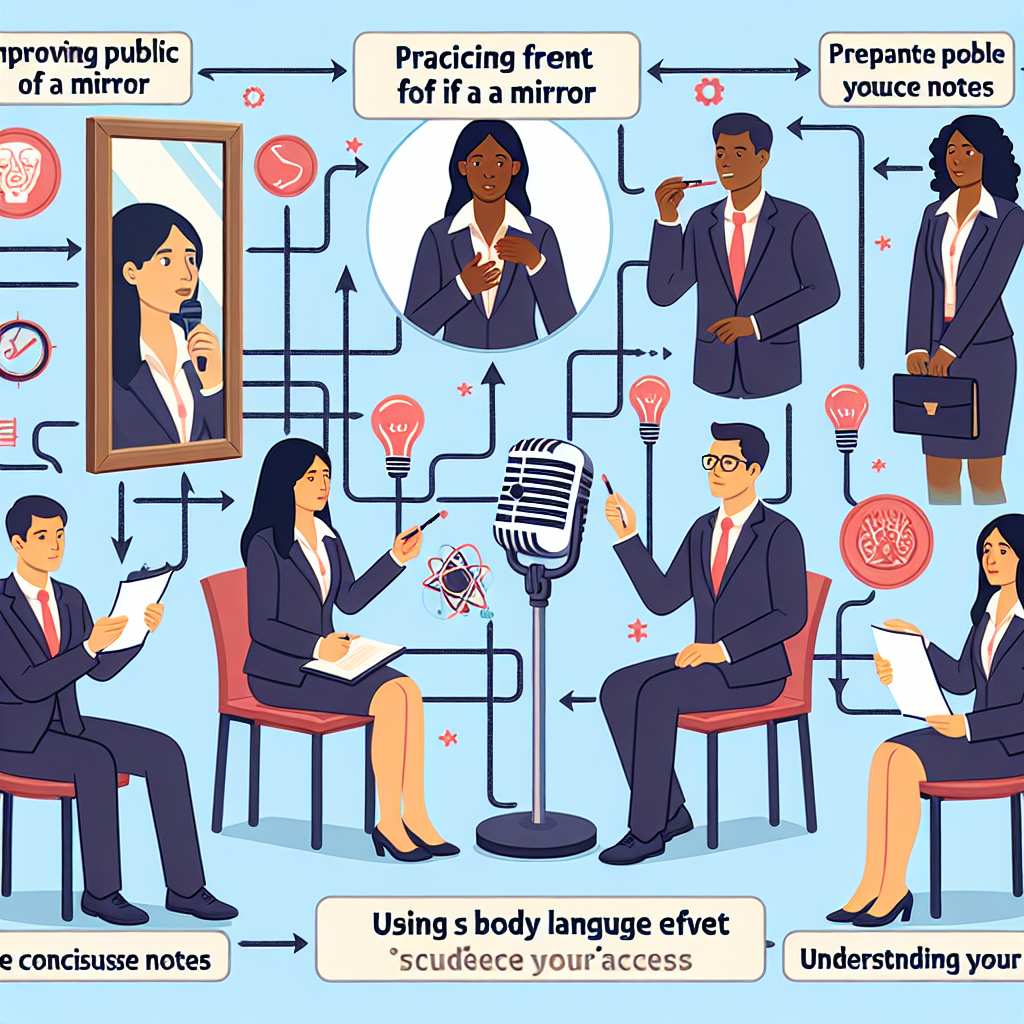
The Power of Practice: 5 Tips for Improving Your Public Speaking Skills
Public speaking is a crucial skill for success in the business world. Whether you are presenting to a small team or speaking in front of a large audience, the ability to effectively communicate your ideas and engage your listeners is essential. However, for many people, the thought of public speaking can be daunting and nerve-wracking. The good news is that with practice and the right techniques, anyone can improve their public speaking skills. In this article, we will explore the power of practice and provide you with five tips to help you improve your public speaking skills for business success.
Tip #1: Know Your Audience
The first step to becoming a successful public speaker is to know your audience. Before your presentation, take some time to research and understand who will be in the room. This will help you tailor your message and delivery to better resonate with your listeners. For example, if you are presenting to a group of executives, your tone and language may be more formal compared to a presentation to a team of colleagues. Knowing your audience will also help you anticipate any potential questions or concerns they may have, allowing you to address them in your presentation.
Tip #2: Practice, Practice, Practice
The saying ”practice makes perfect” holds true for public speaking. The more you practice, the more comfortable and confident you will become. Start by rehearsing your presentation in front of a mirror or with a trusted friend or colleague. This will help you become aware of any nervous habits or distracting gestures that you may need to work on. Additionally, consider recording yourself and watching it back to identify areas for improvement. Remember, the more you practice, the more natural and polished your delivery will be.
Tip #3: Use Visual Aids
Visual aids, such as slides or props, can be powerful tools to enhance your presentation and engage your audience. However, it is essential to use them strategically and not rely on them too heavily. Your visual aids should complement your message, not distract from it. Keep them simple and visually appealing, and use them to highlight key points or data. Also, make sure to practice with your visual aids beforehand to ensure they are working correctly and do not cause any technical difficulties during your presentation.
Tip #4: Engage Your Audience
Engaging your audience is crucial for a successful presentation. One way to do this is by using storytelling. People are naturally drawn to stories, and they can help you connect with your audience on a personal level. Share relevant anecdotes or examples that support your message and make it more relatable. Additionally, make eye contact with your audience and use inclusive language, such as ”we” and ”us,” to make them feel like they are part of the conversation.
Tip #5: Embrace Nervousness
It is normal to feel nervous before a presentation, even for experienced public speakers. Instead of trying to suppress your nerves, embrace them. Nervousness can actually be a good thing as it shows that you care about your presentation and want to do well. Take deep breaths, smile, and remind yourself that you are prepared and knowledgeable about your topic. Also, remember that your audience wants you to succeed, so try to relax and enjoy the experience.
In conclusion, public speaking is a skill that can be learned and improved with practice. By knowing your audience, practicing, using visual aids, engaging your audience, and embracing nervousness, you can become a confident and effective public speaker. Remember, the more you practice, the more comfortable and successful you will become. So, the next time you have a presentation, use these tips and watch your public speaking skills soar.
From Nervous to Confident: Overcoming Stage Fright in Public Speaking
Public speaking is a crucial skill for success in the business world. Whether you are presenting a proposal to potential investors, delivering a keynote speech at a conference, or simply leading a team meeting, the ability to communicate effectively and confidently is essential. However, for many people, the thought of speaking in front of a large audience can be daunting and nerve-wracking. This fear of public speaking, also known as stage fright, can hinder one’s professional growth and limit opportunities for career advancement. But fear not, with some tips and techniques, you can overcome stage fright and improve your public speaking skills for business success.
The first step in overcoming stage fright is to understand that it is a common fear. According to a survey by Chapman University, public speaking is the number one fear among Americans, even surpassing the fear of death. So, if you feel nervous before a presentation, know that you are not alone. It is a natural response to a high-pressure situation. The key is to learn how to manage and channel that nervous energy into a confident and engaging performance.
One effective way to manage stage fright is through preparation. The more prepared you are, the more confident you will feel. Start by thoroughly researching your topic and organizing your thoughts. Create an outline or a script to guide you during your presentation. Practice your speech in front of a mirror or with a friend, and ask for feedback. Rehearsing will not only help you remember your content but also boost your confidence.
Another helpful technique is to focus on your audience. Instead of worrying about your performance, shift your attention to the people you are speaking to. Remember that they are there to listen to you and learn from you. Engage with them by making eye contact, using gestures, and asking questions. This will not only make your audience feel more involved, but it will also help you feel more connected and less nervous.
Breathing exercises can also be beneficial in managing stage fright. Before your presentation, take a few deep breaths to calm your nerves and relax your body. During your speech, remember to pause and take deep breaths to slow down your pace and give yourself a moment to gather your thoughts. Breathing exercises can help reduce anxiety and improve your overall delivery.
Visual aids, such as slides or props, can also be useful in overcoming stage fright. They can serve as a guide for your presentation and help you stay on track. Additionally, they can also divert some of the attention away from you and onto the visual aids, giving you a moment to collect yourself. However, be mindful not to rely too heavily on visual aids, as they should enhance your presentation, not be the main focus.
Finally, remember to be yourself. Authenticity is key in public speaking. Trying to be someone you are not will only add to your nerves and make your presentation less genuine. Embrace your unique style and personality, and let it shine through in your delivery. Your audience will appreciate your authenticity and connect with you on a deeper level.
In conclusion, stage fright is a common fear that can be managed and overcome with the right techniques. By preparing thoroughly, focusing on your audience, using breathing exercises, incorporating visual aids, and being yourself, you can improve your public speaking skills and become a confident and effective speaker. With practice and determination, you can turn your nervousness into confidence and achieve success in your business endeavors. So, the next time you have to give a presentation, remember these tips and embrace the opportunity to showcase your skills and knowledge.
Mastering Nonverbal Communication: Body Language Tips for Effective Public Speaking
Public speaking is a crucial skill for success in the business world. Whether you are presenting to a small team or speaking in front of a large audience, your ability to effectively communicate your ideas can make or break your career. While many people focus on perfecting their verbal communication skills, nonverbal communication, or body language, is just as important in delivering a powerful and persuasive presentation. In this article, we will discuss some tips on how to improve your body language for effective public speaking.
First and foremost, it is important to understand the impact of body language on your audience. Studies have shown that nonverbal cues make up a significant portion of our communication, with some estimates as high as 93%. This means that your body language can convey more than your words, and it is essential to be aware of the messages you are sending through your posture, gestures, and facial expressions.
One of the most crucial aspects of body language in public speaking is maintaining good posture. Standing tall with your shoulders back and your head held high not only exudes confidence but also helps you project your voice and engage with your audience. Slouching or hunching over can make you appear nervous or uninterested, and it can also affect your breathing and vocal projection. Practice standing in front of a mirror and make sure your posture is upright and open.
Another important aspect of body language is eye contact. Making eye contact with your audience shows that you are confident and engaged in your presentation. It also helps you connect with your audience and build rapport. However, be mindful not to stare or make prolonged eye contact with one person, as this can make them feel uncomfortable. Instead, make eye contact with different individuals throughout your presentation to ensure everyone feels included.
Gestures are also a crucial part of nonverbal communication in public speaking. Using hand gestures can help emphasize your points and make your presentation more dynamic. However, be mindful not to overdo it, as too many gestures can be distracting. Use natural and purposeful gestures to enhance your message and avoid fidgeting or repetitive movements, which can make you appear nervous or unprepared.
Facial expressions are another essential aspect of body language in public speaking. Your face is a powerful tool for conveying emotions and engaging with your audience. A smile can make you appear approachable and friendly, while a serious expression can convey authority and confidence. Be mindful of your facial expressions and use them to enhance your message and connect with your audience.
In addition to these tips, it is also crucial to be aware of your body language during the Q&A portion of your presentation. This is often the time when nerves can get the best of us, and our body language can give away our discomfort. Remember to maintain good posture, make eye contact, and use gestures and facial expressions to convey confidence and engagement with your audience.
Lastly, it is essential to practice your body language along with your verbal communication skills. Rehearse your presentation in front of a mirror or with a friend and pay attention to your body language. Ask for feedback and make adjustments as needed. You can also record yourself and watch the playback to see how your body language comes across to others.
In conclusion, mastering nonverbal communication is crucial for effective public speaking and business success. By being mindful of your posture, eye contact, gestures, and facial expressions, you can convey confidence, engage with your audience, and deliver a powerful presentation. Remember to practice and seek feedback to continuously improve your body language and become a more effective public speaker. With these tips in mind, you will be well on your way to mastering nonverbal communication for business success.
Crafting a Compelling Message: Strategies for Engaging Your Audience in Public Speaking
Public speaking is a crucial skill for success in the business world. Whether you are presenting to clients, pitching a new idea to your team, or delivering a keynote speech at a conference, your ability to engage and captivate your audience can make or break your message. Crafting a compelling message is essential for effective public speaking, and there are several strategies you can use to engage your audience and leave a lasting impression.
First and foremost, it is essential to know your audience. Before you even begin crafting your message, take the time to research and understand who will be in the room. What are their interests, backgrounds, and knowledge levels? This information will help you tailor your message to resonate with your audience and make it more relatable. For example, if you are presenting to a group of marketing professionals, you may want to use marketing-specific language and examples to make your message more relevant to them.
Once you have a clear understanding of your audience, it is time to focus on your message. A compelling message is one that is clear, concise, and memorable. Start by identifying the main points you want to convey and then build your message around them. Use simple and straightforward language, avoid jargon, and make sure your message flows logically from one point to the next. Remember, your audience is there to listen to you, not read a textbook, so keep your message engaging and easy to follow.
Another crucial aspect of crafting a compelling message is storytelling. People are naturally drawn to stories, and incorporating them into your message can make it more relatable and memorable. Share personal anecdotes, case studies, or even use humor to illustrate your points. This will not only help you connect with your audience but also make your message more engaging and entertaining.
In addition to storytelling, using visual aids can also enhance your message. Visual aids such as slides, videos, or props can help break up your presentation and make it more dynamic. However, it is essential to use them sparingly and make sure they add value to your message rather than distract from it. Keep your visual aids simple and visually appealing, and make sure they are relevant to your message.
Another strategy for engaging your audience is to involve them in your presentation. This can be done through interactive activities, asking for their opinions or experiences, or even using polls or surveys. By involving your audience, you not only make them feel more invested in your message, but you also get valuable feedback and insights that can enhance your presentation.
Furthermore, body language and vocal delivery play a significant role in engaging your audience. Your body language should be open and confident, and your vocal delivery should be clear and varied. Use hand gestures, make eye contact, and vary your tone and pace to keep your audience engaged. Avoid standing in one spot or reading from notes, as this can make your presentation seem robotic and disengaging.
Lastly, practice makes perfect. Before delivering your message, make sure to rehearse it several times. This will not only help you become more comfortable with your material, but it will also give you the opportunity to fine-tune your message and delivery. Practice in front of a mirror, record yourself, or even ask a friend or colleague to listen and provide feedback. The more you practice, the more confident and engaging you will be when delivering your message.
In conclusion, crafting a compelling message is essential for engaging your audience in public speaking. Know your audience, keep your message clear and concise, incorporate storytelling and visual aids, involve your audience, and practice, practice, practice. By following these strategies, you can improve your public speaking skills and leave a lasting impression on your audience, ultimately leading to business success.
The Art of Q&A: How to Handle Audience Questions and Enhance Your Public Speaking Skills
Public speaking is a crucial skill for success in the business world. Whether you are presenting a proposal to potential investors, pitching a new product to clients, or delivering a keynote speech at a conference, your ability to communicate effectively can make or break your professional reputation. While many people may dread the thought of speaking in front of a large audience, with the right techniques and practice, anyone can become a confident and skilled public speaker.
One aspect of public speaking that often causes anxiety for many individuals is the Q&A session. This is the part of the presentation where the audience has the opportunity to ask questions and engage with the speaker. It can be intimidating to face a barrage of questions, especially if you are not prepared. However, with some tips and strategies, you can handle audience questions with ease and enhance your overall public speaking skills.
The first step to mastering the art of Q&A is to be well-prepared. This means not only knowing your material inside and out but also anticipating potential questions that may arise. Put yourself in the shoes of your audience and think about what they may want to know. This will help you to have a clear and concise answer ready when the time comes. It is also helpful to have some key points written down that you can refer to if needed.
During the Q&A session, it is important to actively listen to the questions being asked. This means maintaining eye contact with the person asking the question and giving them your full attention. It can be tempting to start formulating your response while the question is still being asked, but this can lead to misunderstandings and a lack of connection with the audience. Take a moment to fully understand the question before responding.
When answering questions, it is essential to be confident and concise. Avoid rambling or going off on tangents. Stick to the main point and provide a clear and direct answer. If you are unsure of the answer, it is okay to admit it and offer to follow up with the person later. This shows honesty and integrity, which can enhance your credibility as a speaker.
Another important aspect of handling audience questions is to remain calm and composed. It is natural to feel nervous or anxious when speaking in front of a large group, but it is crucial to maintain your composure. Take a deep breath before responding and speak slowly and clearly. This will not only help you to stay focused but also make it easier for the audience to understand your answer.
In addition to being well-prepared and confident, it is also essential to be respectful and professional when answering questions. This means avoiding any defensive or confrontational responses, even if the question is challenging or critical. Remember that the Q&A session is an opportunity for dialogue and learning, not a debate. Be open-minded and respectful of different perspectives.
Lastly, it is crucial to practice handling audience questions before your actual presentation. This can be done by rehearsing with a friend or colleague and asking them to come up with potential questions. You can also record yourself and watch it back to see how you handle questions and identify areas for improvement. The more you practice, the more comfortable and confident you will become in handling audience questions.
In conclusion, the Q&A session is an integral part of public speaking and can greatly enhance your overall presentation. By being well-prepared, actively listening, remaining calm and composed, and practicing, you can handle audience questions with ease and improve your public speaking skills. Remember to be confident, concise, and respectful in your responses, and you will leave a lasting impression on your audience. With these tips in mind, you can conquer your fear of Q&A and become a skilled and successful public speaker.
We have lots of exciting coming events in Entrepreneurship, Investing and Personal Development. You can find them all here:
www.swedishwealthinstitute.se/events




